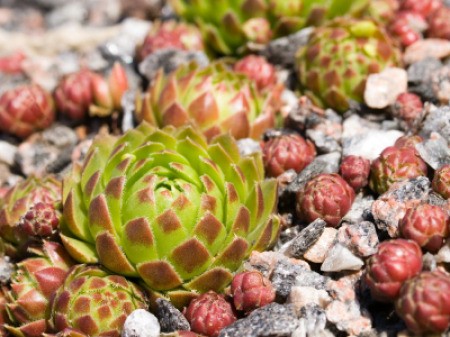
Hen and Chicks are interesting, low-maintenance perennial plants that are rarely troubled by pests. They make wonderful houseplants, yet because they grow best in poor soil conditions, they are also suitable to almost any outdoor garden environment - especially the rock garden. Here's what you need to know to start growing them.
Not everyone looks at these self-perpetuating plants and sees a central hen surrounded by tiny peeping chicks, but nonetheless, they are fascinating. There are over 100 species of them, all of which form low, succulent rosettes of leaves. Some varieties grow only a couple of inches wide, while others spread into mats several feet across.
The leaves may come in a multitude of shades from gray to green to burgundy, many with edges tipped in bright red, pink, purple, or even black. A few hairy varieties look as though a spider has spun its web over the top of the plants.
Hen and chick's botanical name "Senpervivum tectorum", is more logical (and interesting). In Latin, Senpervivium means "always live" (i.e. evergreen) and tectorum means "on roofs". These plants are native to southern Europe, where they were (and still are) grown tucked into the corners of rooftops on Roman houses (without any soil) to hold the slate tiles in place.
This explains the origin of their other common name "houseleeks." In the days when thatched roofs were common, houseleeks were thought to protect houses from lightening and subsequent fires. This idea isn't far-fetched given their succulent nature. Today, some green roofs are planted with these small plants to prevent runoff of rainwater, insulate the building, and encourage energy conservation.
Life cycle: Evergreen perennial.
Hardiness: To zone 3 (depending on variety).
Site: Prefers full sun but will tolerate light shade. Well-drained soil is a must and they will also grow readily in alkaline soil.
Height (without flowers): 1 to 3 inches.
Spread: 2 to 36 inches.
Foliage: Forms clumps of fleshy-leaves, rosettes. They can be gray, rosy pink, or bright to dull red in color; some varieties are covered in silken white filaments called "cobwebs".
Hens and chicks are readily available at garden centers in the spring. They are often sold featuring several different varieties within the same container. When setting out new plants, grow them at the same depth they grew in the pots.
Contact with the soil should be sufficient for transplanting since hens and chicks root readily. Space plants 4 to 6 inches apart to start (large rosettes will require more room). If you misjudge the spacing and your chickens become overcrowded, don't worry! They are easy to divide.
Unlike most perennials, hens and chicks can be divided at any time during the growing season. As tiny new plants (chicks) appear in a circle around the mother plant (hen), divide existing clumps by separating the rosettes and replanting them (the chicks will have their own roots).
To transplant, just press the "chicks" gently into the soil in a new location. As the mother "hen" dies out, young "chicks' take its place and perpetuate a new crop.
Hens and chicks thrive in hot, dry locations where other plants fail. They are ideal for rock gardens, trough gardens, edging borders, and wall crevices. They also grow well in containers. Once established, hens and chicks are extremely drought-tolerant. And while they make interesting ground covers, they will not tolerate any foot traffic.
There are two other perennials that so closely resemble hens and chicks in both appearance and growing needs that you will probably only notice the difference when they are in bloom.

About The Author: Ellen Brown is an environmental writer and photographer and the owner of Sustainable Media, an environmental media company that specializes in helping businesses and organizations promote eco-friendly products and services.
Add your voice! Click below to comment. ThriftyFun is powered by your wisdom!
These are fascinating plants, but I have had a tough time keeping them alive, will have to follow your advice more closely next time!
Sand is key to growing hens and chicks. Mix in sand so the ratio to dirt is about 50%
Thanks so much for this advice. I bought some of these plants in Croatia and transported them to France, with no idea about their name. I just like the look of them. Now they are starting a second year in my very tiny rock garden and they look wonderful. Two have sprouted up about 3-4 inches, and I actually worried if this was bad news, as I am not a very successful gardener. So I am encouraged by your information and will love them even more.
Add your voice! Click below to comment. ThriftyFun is powered by your wisdom!